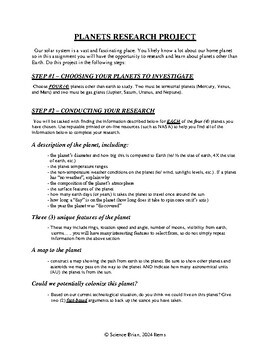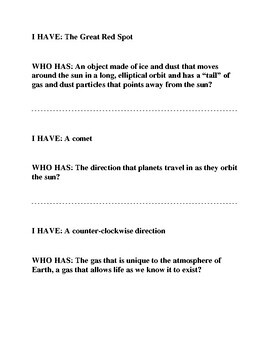Planets and the Solar System Teaching Resources Bundle (Astronomy)
- Zip
Products in this Bundle (3)
Bonus
Description
This bundle contains three (3) items that can be used to help teach a unit on Planets and the Solar System. The items in this bundle include:
- Planets Research Project
- Solar System Crossword Puzzle
- Planets and Solar System I Have Who Has Review Game
Each of these items has its own individual preview available and a full description of each is included below:
Planets Research Project
This project can be used in an Astronomy/Solar System unit. In the project students will select four planets (2 gas giants, 2 terrestrial planets) other than earth to investigate. Students are then given a detailed list of information to find on their chosen planets including:
- Planet size, weather, composition, surface features, year and day lengths, and when planet was discovered
- Unique features of the planet
- The location of the planet in our solar system
- Whether of not the student believes the planet could be colonized
Following their research, students are asked to present their findings using words and diagrams in either a pencil/paper or digital format.
Students will work independently and in my experience the project takes roughly 4 class periods to complete. This is an easy to use project resource for classroom teachers. Also, the simplicity with which it is worded and presented also makes it an ideal resource for substitute teachers who may not have a strong science background.
An easy to use teacher marking scale/rubric is provided.
Solar System Crossword Puzzle
This crossword will serve as good review at the end of an Astronomy unit on the Solar System for late middle school/high school students. To be successful on this crossword students should know the following content:
- What planets are terrestrial and which are gas giants
- Location of the asteroid belt
- General features of the planets (ie/ sizes, atmosphere contents, number of moons and features such as great red spot, great dark sport, rings, volcanoes, etc)
- Which planets have rings
- What are comets, meteors, meteorites, asteroids, craters
- The sun as the center of the solar system and our star
- Definitions for astronomy, revolution, rotation, astronomical year
A full answer key is provided.
Planets and Solar System I Have Who Has Review Game
This 32-item “I Have, Who Has?” game is a fun class activity that can be used as review for students in an upper junior high/high school class at the conclusion of a unit on planets and the solar system. In this particular game, students work as a class to answer questions focused on the vocabulary and knowledge associated with planets and the solar system. The game is easy to play and complete instructions for how to run the game with your class are included.
Vocabulary terms and knowledge your class should be familiar with before playing the game include:
Vocabulary terms needed:
- asteroid belt
- asteroids
- astronomy
- comet
- crater
- great red spot
- Kuiper belt
- meteors
- meteorites
- moons
- rotation
- revolution
- rings
- star
- year
Knowledge needed:
- carbon dioxide in Venus’ atmosphere traps heat, causing high temperatures
- planets travel in elliptical orbits
- be able to identify the four gas giants and four terrestrial planets
- planets revolve around the sun in a counter-clockwise direction
- oxygen in Earth’s atmosphere allows life as we know it to exist
- hydrogen and helium are the main gases in the atmosphere of the gas giants
- the sun is the center of the solar system
- Earth has a solid surface, liquid water, and one moon
- Mercury is the closest planet to the sun and has no atmosphere and no weather
- Venus has a solid surface, many volcanoes, is incredibly hot, and is only slightly smaller than Earth
- Saturn is the second largest planet and is perhaps most famous for its beautiful rings
- Jupiter is the largest planet in our solar system
- Uranus is known as “the sideways planet” because on how it rotates/spins at a 60 degree angle
- Mars has two moons, a solid surface, is about half the size of Earth and is often referred to as “the red planet”
- Neptune is a large gas giant planet with a storm known as the Great Dark Spot
All Item © Science Brian 2024. Single teacher use only





